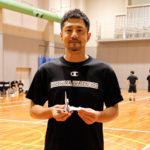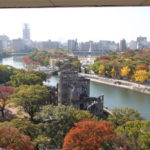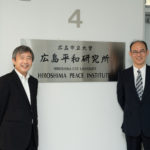II Becoming a Regional Core City
1 Becoming an Industrial City
There were no large-scale factories in Hiroshima during the Meiji period, other than those of the cotton-spinning industry, and industrial production was generally sluggish. The main products manufactured in Hiroshima were matches, canned food, and sewing needles. As an export industry, match production peaked during World War I, but production quickly declined due to international competition and Japan falling behind other nations in the technological innovation. Sewing needle production also peaked during World War I. With improvements in the production process, manufacturing of sewing needles remained a major local industry. The production of canned food, primarily for the navy, flourished during the First Sino-Japanese War and the Russo-Japanese War; and numerous small-scale factories were established. In fact, statistical data from 1923 shows that Hiroshima accounted for 82% of the canned beef production in Japan. The production of canned food was strongly connected to the military and war and increased greatly with the outbreak of the Second Sino-Japanese War.
The Hiroshima Bosekisho (the Hiroshima Spinning Plant), established as a government-run factory in Kamiseno Village in Aki County, was one of the first modern factories in Hiroshima. When the factory was completed in 1882, it was sold off to the Hiroshima Menshi Bosekigaisha (the Hiroshima Cotton Spinning Company), a sheltered work company for former samurai, and began to operate. In 1885, it was relocated to Kawara-machi and was the biggest factory in Hiroshima. The spinning industry remained a key industry in Hiroshima.
After World War I, Teikoku Rayon set up a factory in Minamisenda-machi, Hiroshima. This factory closed after about 10 years. Then, Kinka Rayon set up a factory of its own in Ujina. The production of rubber products and paper manufacturing increased greatly around this time. The metal and machinery industry also began to emerge; and in 1920, Japan Steel Works launched a factory in Hiroshima to manufacture weapons. In the same year, Toyo Cork Kogyo was established. The company’s name was changed to Toyo Kogyo in 1927, and began subcontracted production for the navy. In 1931, Toyo Kogyo relocated to Fuchu Town in Aki County and started production of three-wheeled trucks. During the war, the Hiroshima Industrial Port Construction Project was carried out and Mitsubishi Heavy Industries built the Hiroshima Shipyard in the waterfront of the Eba area and the Hiroshima Machinery Works in the waterfront of the Kannon area. Large factories were built in this way from World War I to World War II. Heavy and chemical industries became Hiroshima’s major industries, which were driven by military demand during the wars. Small and medium-sized companies sprung up as suppliers to these large companies and to the Kure Naval Arsenal. The postwar industrialization of Hiroshima can be seen in these enterprises.
2 Hiroshima as a Center of Learning
Hiroshima was also a center of learning. This started from the establishment of Hiroshima Higher Normal School. Enhancement of secondary education was sought after as a part of state planning after the First Sino-Japanese War, and the second higher normal school was to be established to ensure that enough teachers were educated. Governor Kazuyuki Egi negotiated with the Ministry of Education to invite the second higher normal school to the City of Hiroshima. The prefectural assembly passed a resolution that would provide a site and funding for the school. Through these actions, Hiroshima was chosen as the location of the second higher normal school, which opened in 1902. Hiroshima Higher Normal School in the west and Tokyo Higher Normal School in the east became known as the top two schools in the field of education in the country. In 1929, a department of Hiroshima Higher Normal School was reorganized, and Hiroshima University of Literature and Science established.
In 1920, Hiroshima High Institute of Technology was established. Hiroshima Prefecture invited the construction of this school, when there was a plan to build two new high institutes of technology in Japan. As for high schools, after the Sixth High School was established in Okayama in 1900, it had become an earnest desire of Hiroshima to have a high school in Hiroshima. When the central government planned to drastically increase the number of high schools in the nation in 1918, a large movement began involving Hiroshima Prefecture, the City of Hiroshima, and the private sector. With this, Hiroshima High School was established in 1923. Hiroshima Kenritsu Joshi Senmon Gakko (a women’s school for higher education established by Hiroshima Prefecture) and Hiroshima Jogakuin Senmon Gakko (Hiroshima Jogakuin College) were also established, and the number of schools of higher education increased in Hiroshima. Together with the development of public and private secondary and vocational schools, Hiroshima grew into an academic city – a center of learning.
3 Regional Core City Hiroshima
Hiroshima was a regional core city that boasted a large population after the six big cities in Japan. Many national government offices overseeing the Chugoku region or both the Chugoku and the Shikoku regions were established in Hiroshima. Similarly, many nationwide businesses also chose to set up branch offices in Hiroshima. Branch offices of government and businesses were located in Hiroshima, including the Chugoku District Marine Transport Bureau of the Ministry of Transport; the Hiroshima Appellate Court; the Hiroshima Management Department of Japanese National Railways; the Hiroshima Communications Bureau of the Ministry of Communications; the Hiroshima Regional Finance Bureau of the Ministry of Finance; as well as branch offices of the Hiroshima Central Broadcasting Bureau, the Bank of Japan, the Dai-Ichi Kangyo Bank and Nippon Express.
Also, the headquarters of prefectural-wide companies chose Hiroshima City as the location for their central offices. Power companies and banks had been established in each region of the prefecture during the Meiji period, but after repeated join-ups and large-scale growth, mergers were carried out under regulations on businesses enacted during the war (the Asia-Pacific War). Later, Geibi Bank, formed as a result of the merging of seven banks in 1920, merged with other banks one after another from both within and outside the prefecture. As a result, there were five banks left, and in April 1945, they were merged into Geibi Bank, making it the only regional bank in Hiroshima. As for power companies, small companies that were set up at various places were absorbed by Hiroshima Dento (Hiroshima Electric Light Company) and Hiroshima Kure Denryoku (Hiroshima Kure Electric Power), and in 1921, these two companies merged to form Hiroshima Denki (Hiroshima Electric). During the war, national management of the power companies was pushed forward, and Chugoku Haiden (the Chugoku Electric Power Distribution Company) was established to distribute electricity to the entire Chugoku region. In this way, people, money, and goods of this region concentrated in the City of Hiroshima.
(Fukuhei Ando)
References
City of Hiroshima. Shinshu Hiroshima Shishi (History of the City of Hiroshima: New Edition). Mar 1958 – Feb 1961. Total in 7 volumes.
Hiroshima Prefecture. Hiroshima Kenshi: Kindai 2 (History of Hiroshima Prefecture: Modern History 2). Mar 1981.







